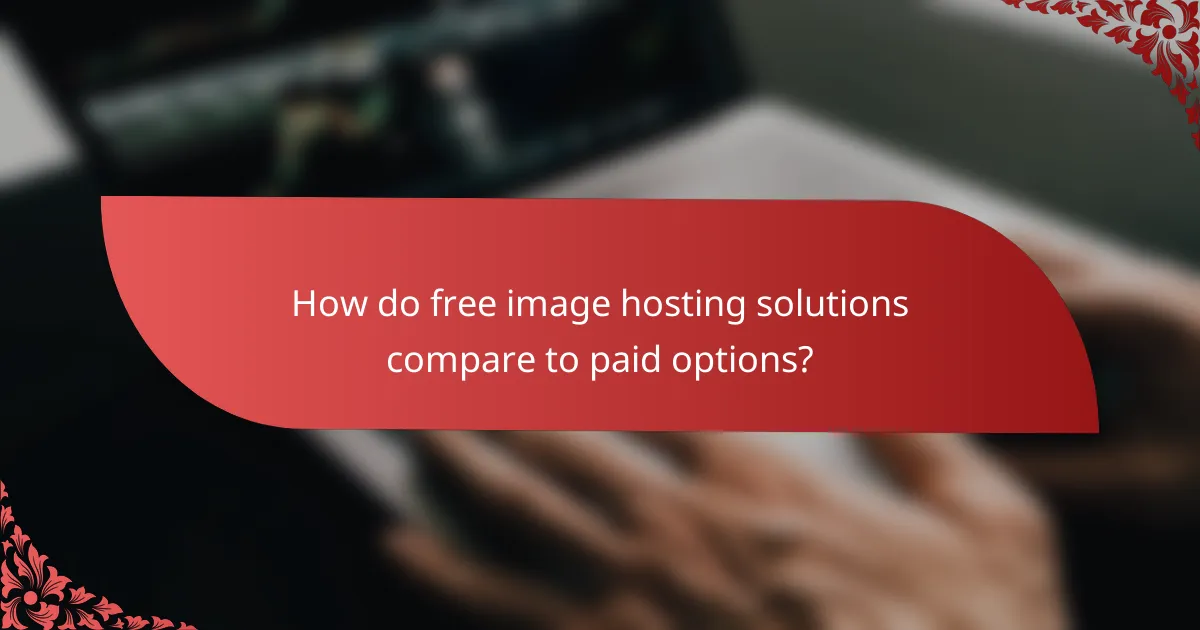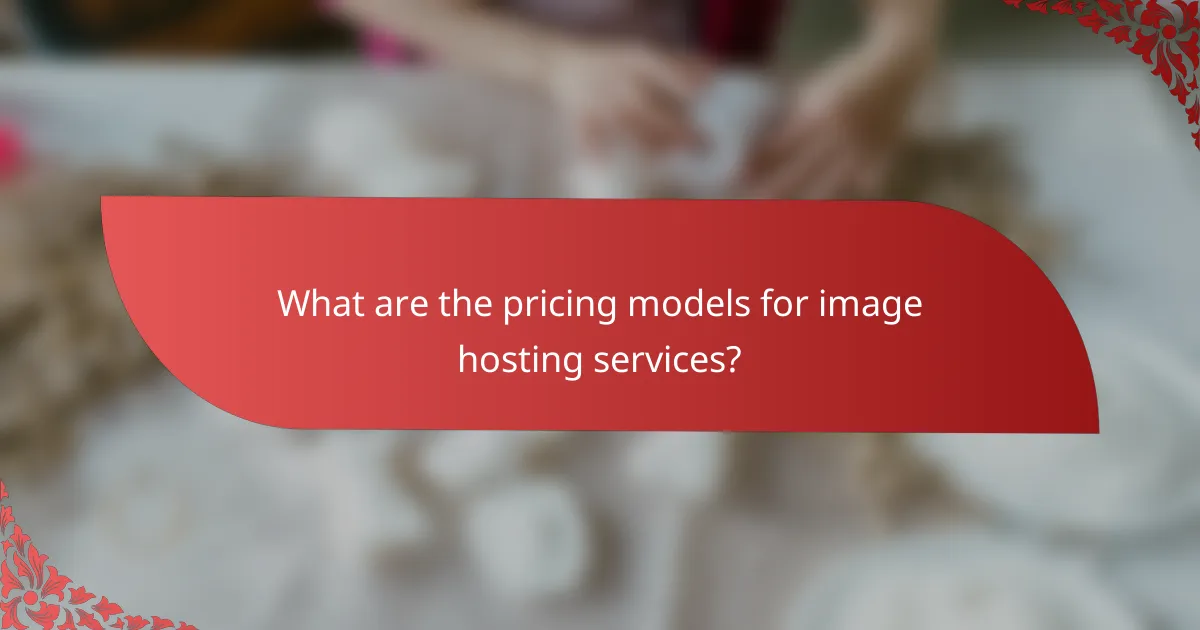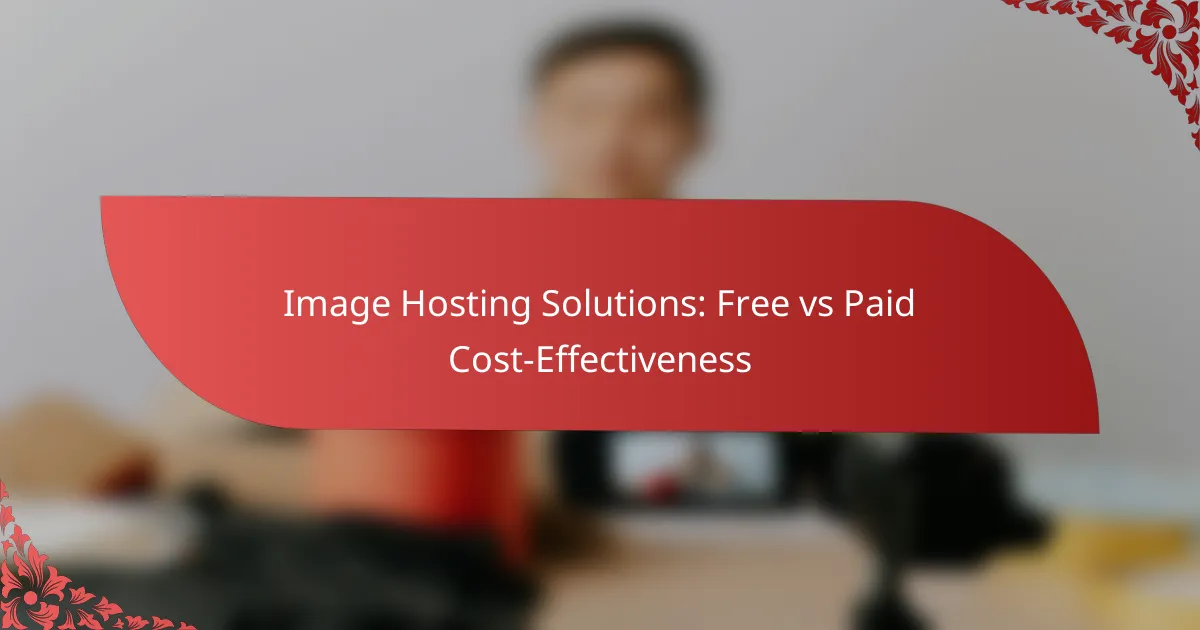When choosing an image hosting solution, it’s essential to weigh the benefits of free versus paid options, especially in Canada where diverse needs exist. Free services may appeal to individuals and small projects due to their cost-effectiveness, but they often come with limitations that can impact usability. In contrast, paid solutions provide enhanced features, greater storage, and better reliability, making them ideal for businesses and professionals seeking more control over their images.

What are the best image hosting solutions in Canada?
In Canada, the best image hosting solutions include a mix of free and paid options that cater to various needs. Factors such as storage capacity, user interface, and additional features play a significant role in determining the right choice for individuals and businesses.
Imgur
Imgur is a popular free image hosting platform known for its simplicity and ease of use. Users can upload images without creating an account, making it ideal for quick sharing. However, while Imgur offers unlimited storage, images may be subject to deletion after a period of inactivity.
For casual users, Imgur’s community features, such as commenting and voting, enhance engagement. However, businesses looking for branding options may find its lack of customization limiting.
Flickr
Flickr is a robust image hosting service that offers both free and paid plans. The free version allows users to upload up to 1,000 photos, while the Pro plan provides unlimited storage and advanced features like ad-free browsing and enhanced statistics. This makes Flickr suitable for photographers and creatives who want to showcase their work.
Flickr’s community aspect encourages networking and sharing within the photography community. However, users should be aware of copyright settings to protect their images effectively.
Google Photos
Google Photos is a versatile image hosting solution that integrates seamlessly with other Google services. It offers free storage with some limitations on image quality, while paid plans provide additional space and features. Users benefit from automatic backup and powerful search capabilities.
For those who prioritize accessibility and organization, Google Photos is an excellent choice. However, users should consider privacy settings, as images are stored on Google’s servers.
SmugMug
SmugMug is a premium image hosting service designed for photographers and businesses. It offers customizable galleries, e-commerce options, and unlimited storage with various subscription plans. This makes it a strong choice for professionals looking to sell their work or create a personalized portfolio.
While SmugMug provides extensive features, it comes at a higher cost compared to free options. Users should evaluate their need for advanced functionalities against their budget.
Cloudinary
Cloudinary is a cloud-based image hosting solution that focuses on developers and businesses needing advanced image management. It offers powerful APIs for image uploading, transformation, and delivery, making it suitable for websites and applications.
While Cloudinary provides a free tier, businesses may need to invest in paid plans for higher usage and additional features. Its flexibility and performance make it a compelling option for tech-savvy users.

How do free image hosting solutions compare to paid options?
Free image hosting solutions can be a cost-effective choice for individuals and small projects, but they often come with limitations that may affect usability and quality. Paid options typically offer enhanced features, better reliability, and more control over your images.
Cost savings of free solutions
Free image hosting solutions allow users to upload and share images without any financial commitment, making them ideal for personal use or small businesses with limited budgets. Many platforms provide basic features such as unlimited storage or bandwidth, which can be sufficient for casual users.
However, while the initial cost is zero, consider potential hidden costs, such as advertising on the platform or limitations on image resolution. For example, some free services may restrict file sizes or limit the number of images you can upload within a certain timeframe.
Limitations of free hosting
Free image hosting often comes with several restrictions that can hinder your experience. Common limitations include lower storage capacity, slower upload speeds, and reduced image quality. Additionally, free services may impose bandwidth limits, leading to potential downtime if your images receive high traffic.
Another significant drawback is the lack of customer support and security features. Free platforms may not offer the same level of protection against data loss or hacking as paid services, which can be critical for businesses relying on their images for branding and marketing. Users should weigh these limitations against their needs before choosing a free solution.

What are the key features of paid image hosting services?
Paid image hosting services typically offer enhanced features compared to free options, including greater storage capacity, advanced customization, and dedicated customer support. These features make them more suitable for businesses and professional photographers who require reliable and scalable solutions.
Storage capacity
Paid image hosting services generally provide significantly more storage than free alternatives, often ranging from several gigabytes to unlimited space. This is crucial for users with large image libraries or those who frequently upload high-resolution files. When selecting a service, consider your current and future storage needs to avoid running out of space.
Some providers offer tiered plans based on storage requirements, allowing users to choose a plan that fits their budget and usage. For example, a plan might start at around $5 per month for 100 GB, scaling up to $50 for unlimited storage.
Customization options
Customization options in paid image hosting services allow users to tailor their galleries and presentations to match their branding. This can include personalized URLs, custom themes, and the ability to modify layouts and styles. Such flexibility is particularly beneficial for businesses wanting to create a cohesive online presence.
Additionally, some services provide advanced features like watermarking, image optimization, and SEO tools, which can enhance visibility and protect intellectual property. Evaluate these options based on how they align with your specific needs and goals.
Customer support
Paid image hosting services often come with robust customer support, including 24/7 assistance via chat, email, or phone. This level of support is essential for resolving issues quickly, especially for businesses that rely on their images for sales and marketing. In contrast, free services may offer limited or no support, which can lead to frustration during critical times.
When choosing a service, consider the types of support offered and the average response times. Some providers may also have dedicated account managers for higher-tier plans, ensuring personalized assistance and guidance.

What factors should you consider when choosing an image hosting solution?
When selecting an image hosting solution, consider factors such as your target audience’s needs, integration capabilities, and scalability. These elements will help you determine the best option for your specific requirements, whether you choose a free or paid service.
Target audience needs
Understanding your target audience is crucial when choosing an image hosting solution. Consider their preferences for image quality, loading speed, and accessibility. For instance, if your audience primarily uses mobile devices, ensure that the hosting service optimizes images for mobile viewing.
Additionally, think about the types of images your audience expects. If your users require high-resolution images for professional use, a paid service may be more suitable, as it often offers better quality and storage options compared to free alternatives.
Integration capabilities
Integration capabilities refer to how well the image hosting solution works with your existing tools and platforms. A good image hosting service should seamlessly integrate with your website, content management system (CMS), or social media platforms. This ensures a smooth workflow and enhances user experience.
Evaluate the APIs and plugins available for the hosting service. For example, if you use WordPress, look for hosting solutions that offer dedicated plugins for easy image uploads and management. This can save time and reduce technical issues.
Scalability
Scalability is the ability of an image hosting solution to grow with your needs. As your website or project expands, you may require more storage space and bandwidth. Free hosting options often come with limitations that can hinder your growth.
When considering scalability, look for services that offer tiered pricing plans. This allows you to start with a basic plan and upgrade as your needs increase. Paid solutions typically provide more flexibility and features to accommodate larger volumes of images and traffic.

What are the pricing models for image hosting services?
Image hosting services typically operate under two main pricing models: monthly subscription plans and pay-per-use pricing. Understanding these models helps users choose the most cost-effective solution based on their needs and usage patterns.
Monthly subscription plans
Monthly subscription plans charge users a fixed fee for a set amount of storage and features. These plans are ideal for businesses or individuals who regularly upload and manage a large number of images. Prices can vary widely, often ranging from around $5 to $50 per month, depending on the storage capacity and additional features offered.
When considering a subscription plan, evaluate your expected usage. If you anticipate needing frequent access to your images or require advanced features like analytics or custom domains, a subscription may provide better value. However, be cautious of long-term commitments that may not align with your usage patterns.
Pay-per-use pricing
Pay-per-use pricing allows users to pay only for the storage and bandwidth they actually consume. This model is beneficial for those with fluctuating needs or occasional image uploads. Costs can vary widely, with fees typically charged per gigabyte stored or per image served, making it a flexible option for users with unpredictable usage.
To maximize cost-effectiveness with pay-per-use, monitor your usage closely and consider setting limits to avoid unexpected charges. This model can be particularly advantageous for small projects or seasonal campaigns where image hosting needs are temporary and variable.
